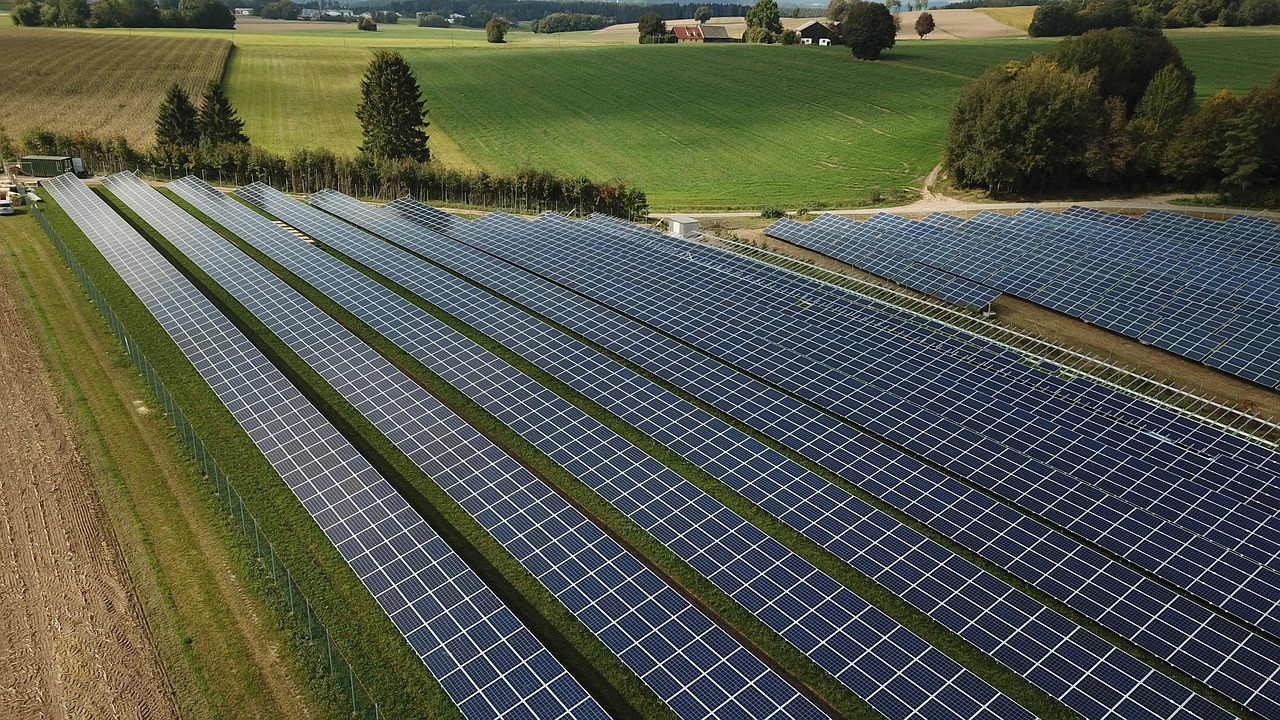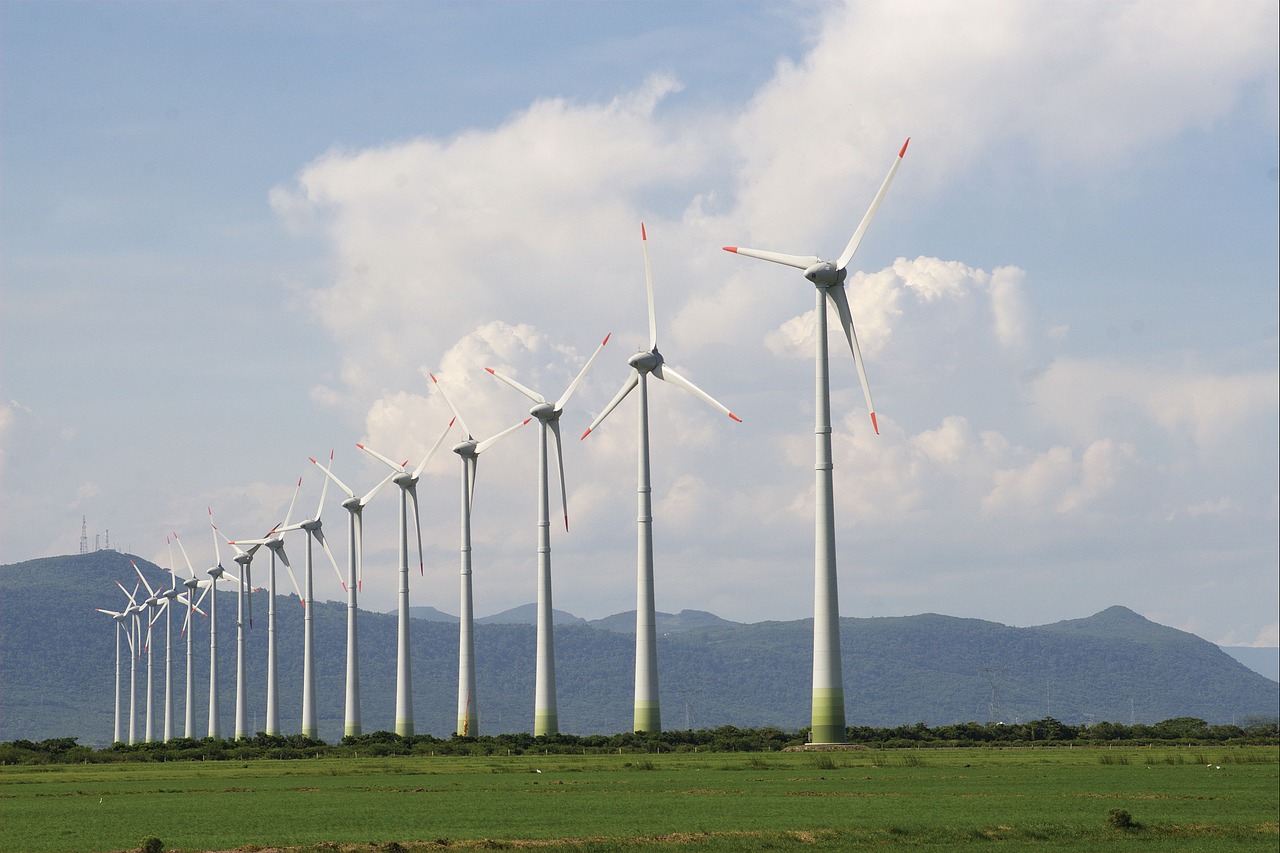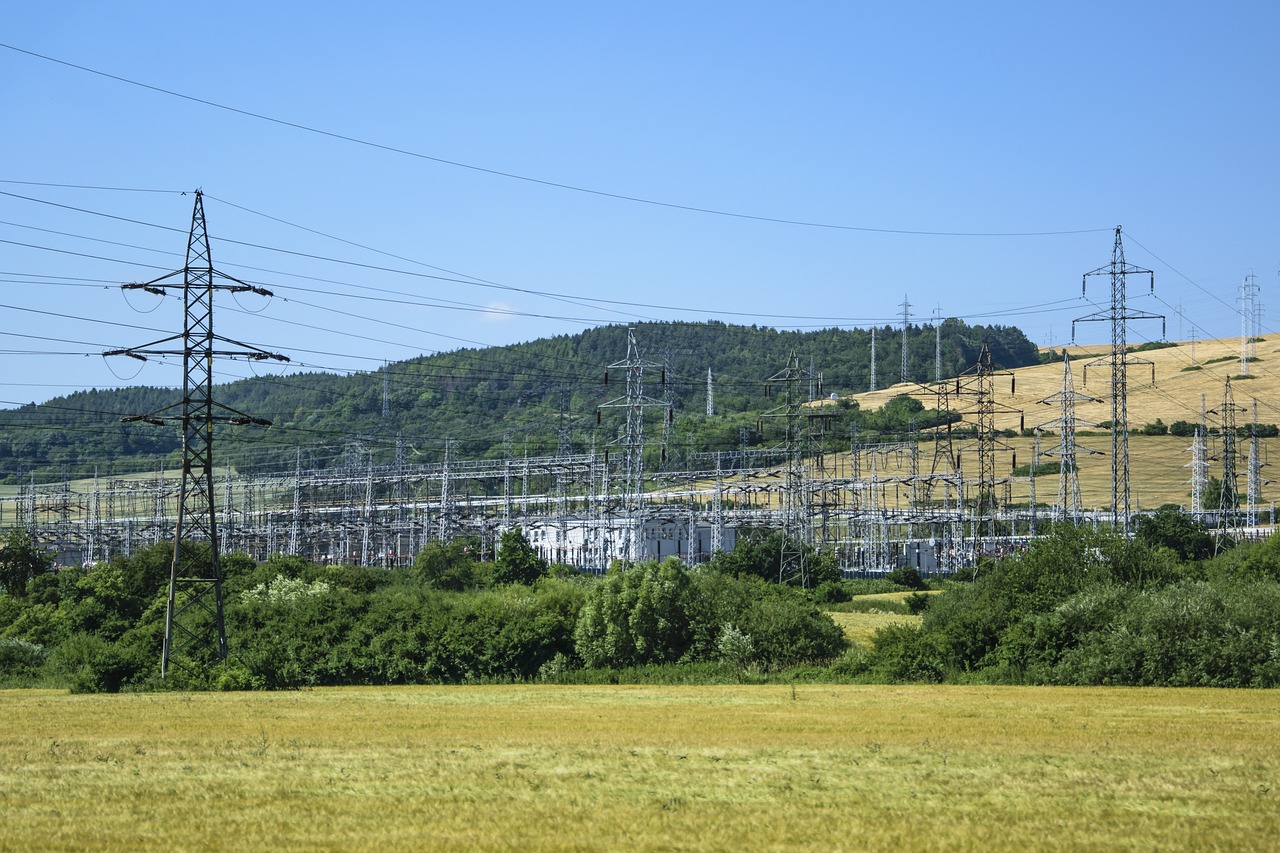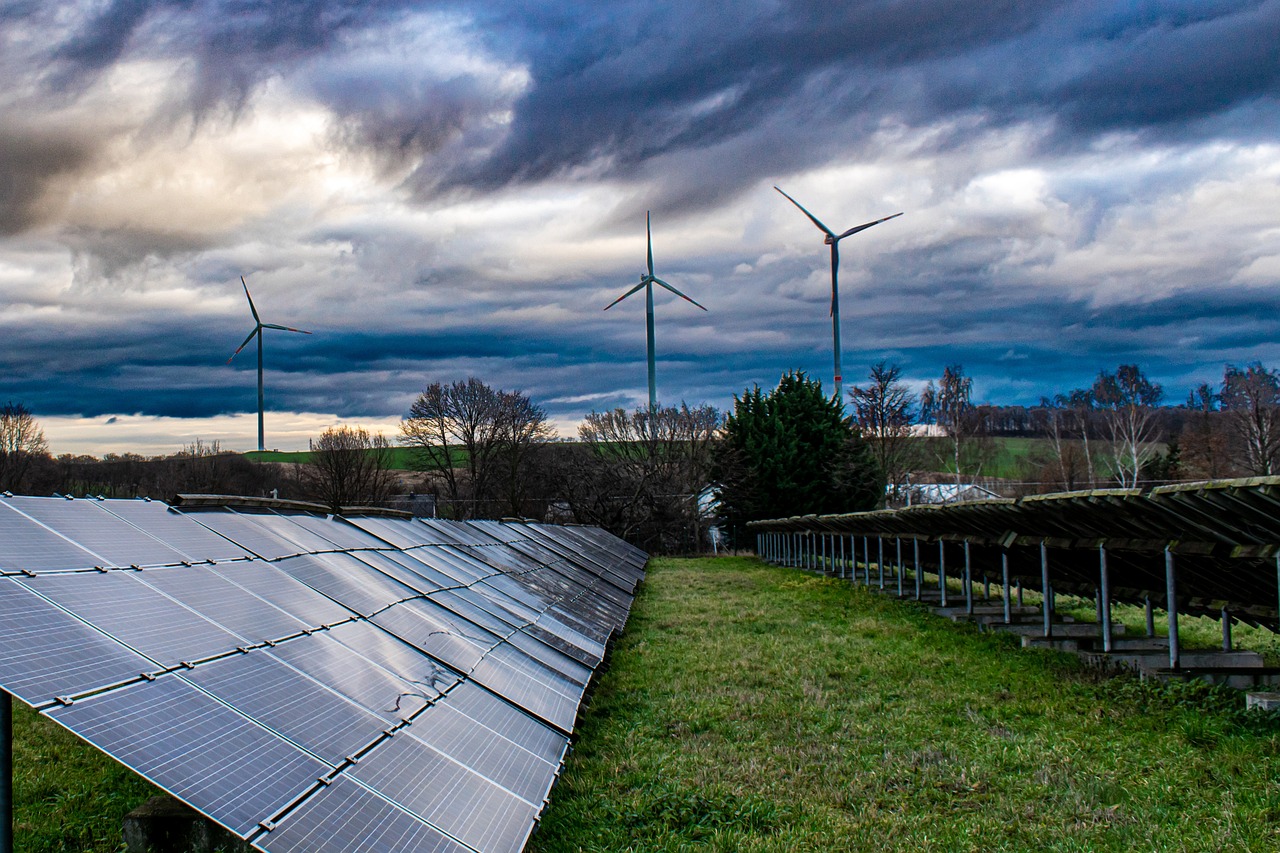Exploring the Potential of Biomass Energy
Biomass energy is rapidly gaining traction as a sustainable and renewable energy source, capturing the attention of environmentalists, policymakers, and energy enthusiasts alike. But what exactly is biomass energy? In simple terms, it is derived from organic materials—think of it as nature's gift to us in the form of plant and animal waste. This energy can be converted into various usable forms, such as heat, electricity, and biofuels, providing an alternative to fossil fuels. As we delve into this fascinating topic, you'll discover how biomass energy not only contributes to our energy needs but also plays a significant role in addressing environmental challenges. So, buckle up as we explore the benefits, challenges, and future prospects of this incredible energy source!
Biomass energy is essentially energy produced from organic matter. It includes a wide array of sources, such as agricultural crops, wood, and even municipal waste. These materials can be transformed into energy through various processes, including combustion, fermentation, and anaerobic digestion. Imagine turning leftover food scraps or agricultural residues into fuel for your car or heat for your home—that's the magic of biomass energy! This section will dive deeper into the definition of biomass energy, its sources, and the different methods used to convert it into usable energy forms.
The benefits of biomass energy are plentiful, making it an attractive option for sustainable energy solutions. First and foremost, it contributes to a reduction in greenhouse gas emissions, which is crucial in our fight against climate change. When biomass is burned, it releases carbon dioxide, but the plants that created this biomass absorbed carbon dioxide during their growth, effectively creating a closed carbon loop. This makes biomass energy a more environmentally friendly alternative compared to fossil fuels.
When we talk about the environmental impact of biomass energy, we are looking at a multifaceted picture. Biomass energy contributes to reducing carbon footprints and improving air quality. By utilizing organic waste, we can divert materials from landfills, which not only reduces methane emissions—a potent greenhouse gas—but also promotes biodiversity. When forests and agricultural lands are managed sustainably, they can thrive, providing habitats for a variety of species while also serving as a renewable energy source.
One of the most compelling arguments for biomass energy is its potential for carbon neutrality. The carbon cycle involved in biomass energy is fascinating. When biomass is harvested, processed, and utilized for energy, it releases carbon dioxide. However, this CO2 is part of a cycle that includes the regrowth of plants that absorb CO2, thus offsetting the emissions. This balance is crucial in mitigating climate change, provided that biomass is managed sustainably and responsibly.
Utilizing biomass energy is also a powerful tool for waste reduction. By converting agricultural and municipal waste into energy, we not only reduce landfill use but also promote recycling efforts. This process transforms what would be waste into a valuable resource, creating a circular economy. For instance, food waste can be converted into biogas through anaerobic digestion, which can then be used for heating or electricity generation. This not only cuts down on waste but also provides a sustainable energy source.
The biomass energy sector is brimming with economic opportunities. From job creation in rural areas to local energy production, biomass energy can stimulate economic growth. It can provide new avenues for farmers, who can sell their crop residues or engage in energy crop production. Additionally, the development of biomass facilities can lead to job creation in manufacturing, transportation, and maintenance. By investing in biomass energy, we can foster rural development and enhance energy independence.
Despite its numerous advantages, biomass energy is not without challenges. Resource availability is a significant concern, as the demand for biomass may compete with food production. Sustainability is critical here; we must ensure that we are not depleting resources or harming ecosystems in the process of harvesting biomass. Furthermore, technological barriers exist that hinder the efficiency of biomass energy production. Innovations are necessary to improve conversion processes and enhance the overall viability of biomass as a mainstream energy source.
The availability of biomass resources can be unpredictable, especially in the face of climate change. Factors such as droughts, floods, and changing weather patterns can impact crop yields and biomass supply. This unpredictability poses challenges for energy producers who rely on a steady supply of organic materials. Sustainable sourcing practices are essential to ensure that biomass energy can continue to grow without negatively impacting food security.
On the technological front, significant advancements are needed to enhance the efficiency of biomass energy production. Current conversion processes can be costly and inefficient, making it challenging for biomass to compete with other energy sources. Research and innovation are critical to developing new technologies that can streamline biomass conversion, reduce costs, and improve overall energy yield.
The future of biomass energy looks promising, with ongoing advancements in technology and supportive policies paving the way for growth. As we continue to innovate, the potential for biomass to play a central role in our energy landscape becomes increasingly apparent. With a focus on emerging technologies and supportive regulatory frameworks, biomass energy could significantly contribute to a sustainable energy future.
Emerging technologies in biomass energy production are exciting and hold great promise. Advanced biofuels and biogas systems are at the forefront of this innovation, with the potential to enhance efficiency and reduce costs. Imagine a world where your car runs on fuel derived from agricultural waste or where your home is heated by energy generated from food scraps. This vision is becoming a reality as research progresses in the field of biomass technology.
Government policies play a crucial role in the development of biomass energy. Current regulations and incentives can provide the necessary support for the growth of the biomass sector. International agreements aimed at reducing carbon emissions also encourage countries to invest in renewable energy sources like biomass. By fostering a supportive policy environment, we can unlock the full potential of biomass energy and ensure its place in our sustainable energy future.
What is biomass energy? Biomass energy is derived from organic materials, including plant and animal waste, which can be converted into usable energy forms like heat and electricity.
Is biomass energy sustainable? Yes, biomass energy can be sustainable if sourced responsibly and managed properly to avoid depleting natural resources.
What are the main benefits of biomass energy? The main benefits include reduced greenhouse gas emissions, waste reduction, job creation, and energy independence.
What challenges does biomass energy face? Challenges include resource availability, competition with food production, and technological barriers to efficiency.
What is the future of biomass energy? The future looks bright, with advancements in technology and supportive policies likely to enhance the role of biomass in the energy sector.

What is Biomass Energy?
Biomass energy is a fascinating and versatile form of renewable energy derived from organic materials. Essentially, it encompasses any biological material that comes from living or recently living organisms. This includes a wide range of sources such as plants, wood, crop residues, animal waste, and even algae. The beauty of biomass energy lies in its ability to be converted into various usable forms of energy, such as heat, electricity, and biofuels.
When we talk about biomass energy, it's important to understand the different methods of conversion. Biomass can be transformed through processes like combustion, anaerobic digestion, and fermentation. For instance, when biomass is burned, it releases heat that can be used for heating homes or generating steam to produce electricity. Alternatively, anaerobic digestion involves breaking down organic matter in the absence of oxygen, producing biogas that can be harnessed for energy. This versatility makes biomass a crucial player in the quest for sustainable energy solutions.
One of the standout features of biomass energy is its potential to contribute to energy independence. By utilizing locally sourced organic materials, communities can reduce their reliance on imported fossil fuels, leading to a more resilient energy system. Additionally, biomass energy can help in managing waste effectively. Agricultural and municipal waste, which would otherwise end up in landfills, can be converted into energy, thus promoting a circular economy.
To give you a clearer picture of the types of biomass sources, here’s a quick overview:
| Type of Biomass | Examples | Energy Conversion Method |
|---|---|---|
| Plant Material | Wood, Crops, Grasses | Combustion, Gasification |
| Animal Waste | Dairy Manure, Poultry Litter | Anaerobic Digestion |
| Algae | Microalgae, Seaweed | Fermentation, Extraction |
In summary, biomass energy is not just a buzzword; it's a practical and sustainable energy solution that can help us transition away from fossil fuels. By tapping into the potential of organic materials, we can create a cleaner, greener future while addressing waste management issues. As we explore the benefits and challenges of biomass energy in the upcoming sections, it’s clear that this renewable resource holds significant promise for both the environment and the economy.

Benefits of Biomass Energy
Biomass energy is often hailed as a sustainable solution to our growing energy demands, and for good reason. It offers a plethora of advantages that can significantly contribute to environmental sustainability and economic growth. One of the most compelling benefits is its potential to reduce greenhouse gas emissions. Unlike fossil fuels, which release carbon dioxide and other harmful pollutants into the atmosphere, biomass energy can be produced from organic materials that are part of the natural carbon cycle. This means that when biomass is burned for energy, it releases carbon dioxide that was recently absorbed by the plants used for fuel, creating a carbon-neutral cycle.
Moreover, biomass energy promotes energy independence. By utilizing locally sourced organic materials, countries can reduce their reliance on imported fossil fuels, which not only enhances energy security but also stimulates local economies. This leads to job creation in rural areas, as biomass energy projects often require a workforce for harvesting, processing, and converting biomass into usable energy. In fact, the biomass sector is projected to generate thousands of jobs across various skill levels, helping to revitalize communities that may be struggling economically.
Another significant benefit of biomass energy is its role in waste reduction. Agricultural residues, food waste, and other organic materials that would otherwise end up in landfills can be converted into energy. This not only helps to minimize landfill use but also promotes recycling efforts. By turning waste into a valuable resource, biomass energy contributes to a more circular economy. In this regard, biomass energy serves as a dual solution—addressing both energy needs and waste management challenges.
In addition to these advantages, biomass energy can also improve air quality compared to traditional fossil fuels. When biomass is burned correctly, it emits fewer pollutants and particulates, leading to cleaner air in the surrounding communities. This is particularly important as air quality continues to decline in many urban areas around the world. The shift towards biomass energy can thus be seen as a step towards healthier living environments.
To summarize, the benefits of biomass energy are numerous and impactful. From reducing greenhouse gas emissions and enhancing energy independence to creating jobs and promoting waste reduction, biomass energy stands out as a viable alternative in the quest for sustainable energy solutions. As we continue to explore and innovate in this field, the potential for biomass energy to play a crucial role in our energy future becomes increasingly evident.
- What is biomass energy? Biomass energy is derived from organic materials, such as plants and animal waste, and can be converted into heat, electricity, and biofuels.
- Is biomass energy renewable? Yes, biomass energy is considered renewable because it relies on organic materials that can be replenished over time.
- How does biomass energy impact the environment? Biomass energy can reduce greenhouse gas emissions, improve air quality, and promote waste reduction, making it a more environmentally friendly option compared to fossil fuels.
- What are the economic benefits of biomass energy? Biomass energy can create jobs, stimulate local economies, and promote energy independence, providing various economic opportunities.

Environmental Impact
When we think about energy sources, the environmental impact is often at the forefront of our minds. Biomass energy stands out for its potential to significantly reduce our carbon footprint. Unlike fossil fuels, which release carbon dioxide that has been trapped underground for millions of years, biomass energy operates on a different principle. It utilizes organic materials that are part of the current carbon cycle. This means that when biomass is burned for energy, the carbon dioxide released is roughly equivalent to what the plants absorbed during their growth. Thus, biomass is often touted as a carbon-neutral energy source, provided it is sourced sustainably.
Moreover, biomass energy contributes to improved air quality. While burning any material releases pollutants, biomass can be managed in a way that minimizes harmful emissions. For instance, modern biomass facilities often incorporate advanced filtration systems that capture particulates and other pollutants before they enter the atmosphere. This is a significant improvement over traditional fossil fuel combustion, which is notorious for its contribution to air pollution and associated health problems.
Another noteworthy aspect of biomass energy is its positive impact on biodiversity. By utilizing agricultural waste and other organic materials, biomass energy production can help reduce the pressure on natural ecosystems. For example, converting crop residues into energy means less reliance on virgin forests and natural habitats for fuel. This shift not only preserves biodiversity but also enhances the sustainability of agricultural practices. Farmers can benefit from this cycle by gaining an additional revenue stream from their waste products, creating a win-win situation for both the economy and the environment.
However, it is essential to approach biomass energy with a balanced perspective. While it has numerous environmental benefits, it's crucial to ensure that biomass is sourced responsibly. Unsustainable harvesting practices can lead to deforestation, habitat destruction, and biodiversity loss. Therefore, implementing strict regulations and guidelines is vital to ensure that biomass energy remains a viable and environmentally friendly option.
In summary, the environmental impact of biomass energy is multifaceted. It offers a promising alternative to fossil fuels, with benefits ranging from carbon neutrality to improved air quality and enhanced biodiversity. Nevertheless, the key to maximizing these benefits lies in sustainable practices that protect our ecosystems while harnessing the power of organic materials for energy.
- What is biomass energy? Biomass energy is derived from organic materials, such as plants and waste, which can be converted into heat, electricity, or biofuels.
- Is biomass energy renewable? Yes, biomass energy is considered renewable as it relies on organic materials that can be replenished over time.
- How does biomass energy impact the environment? Biomass energy can reduce greenhouse gas emissions, improve air quality, and promote biodiversity when sourced sustainably.
- What are the challenges of biomass energy? Challenges include resource availability, competition with food production, and technological barriers to efficient energy conversion.
- What is the future of biomass energy? The future looks promising, with advancements in technology and supportive policies driving growth in the biomass sector.

Carbon Neutrality
When we talk about in the context of biomass energy, we’re diving into a fascinating concept that ties together nature, technology, and our responsibility towards the planet. At its core, biomass energy is often considered carbon neutral because the carbon dioxide (CO2) released during the combustion of biomass is roughly equivalent to the amount of CO2 that the plants absorbed during their growth. This means that, theoretically, using biomass as an energy source does not add extra carbon to the atmosphere, unlike fossil fuels, which release ancient carbon that has been locked away for millions of years.
However, achieving true carbon neutrality with biomass energy is not as straightforward as it sounds. It hinges on several critical factors:
- Sustainable Sourcing: Biomass must be sourced sustainably to ensure that the carbon cycle remains balanced. This involves responsible forest management and agricultural practices that do not deplete resources or harm ecosystems.
- Lifecycle Emissions: It’s essential to consider the entire lifecycle of biomass production, from cultivation to transportation and processing. Each stage can contribute to greenhouse gas emissions, potentially offsetting the carbon neutrality of the end product.
- Land Use Changes: Converting forests or natural land into biomass production areas can release stored carbon and diminish biodiversity, which is counterproductive to the goal of reducing atmospheric CO2 levels.
To better understand the carbon cycle involved in biomass energy, let’s break it down:
| Stage | Carbon Impact |
|---|---|
| Growth | Plants absorb CO2 from the atmosphere, storing carbon as biomass. |
| Harvesting | Carbon remains stored until the biomass is utilized. |
| Combustion | CO2 is released back into the atmosphere, completing the cycle. |
When managed sustainably, biomass energy can play a significant role in mitigating climate change. By utilizing waste materials and dedicated energy crops, we can reduce reliance on fossil fuels and lower overall greenhouse gas emissions. The key lies in finding a balance—ensuring that our methods of harvesting and using biomass do not tip the scales away from sustainability.
In summary, while biomass energy holds great promise for achieving carbon neutrality, it requires careful planning, responsible practices, and ongoing innovation. By addressing the challenges and optimizing the processes involved in biomass energy production, we can harness its potential to combat climate change effectively.
- What is biomass energy? Biomass energy is derived from organic materials such as plants and waste. It can be converted into heat, electricity, and biofuels.
- Is biomass energy truly carbon neutral? Biomass can be considered carbon neutral if sourced sustainably, as the CO2 released during combustion is offset by the CO2 absorbed during growth.
- What are the main sources of biomass? Common sources include agricultural residues, wood, dedicated energy crops, and municipal solid waste.
- How does biomass energy impact the environment? When managed properly, biomass energy can reduce greenhouse gas emissions, improve air quality, and promote biodiversity.

Waste Reduction
One of the most compelling aspects of biomass energy is its role in . In a world grappling with overflowing landfills and the pressing need for sustainable waste management solutions, biomass energy emerges as a beacon of hope. By converting organic waste into energy, we not only address the waste crisis but also produce valuable energy resources. This dual benefit is akin to hitting two birds with one stone—solving two critical issues simultaneously.
Consider this: every year, millions of tons of agricultural residues, food scraps, and municipal waste end up in landfills. These materials, which could otherwise be transformed into energy, contribute to greenhouse gas emissions as they decompose. By harnessing biomass energy, we can divert this waste from landfills and reduce our carbon footprint. The process involves collecting organic waste, such as crop leftovers, animal manure, and even food waste, and converting it into usable energy forms. This not only lessens the burden on landfills but also promotes a circular economy where waste is viewed as a resource rather than a problem.
The conversion process typically involves several methods, including anaerobic digestion, combustion, and gasification. Each method has its unique advantages and applications, which can be tailored to specific waste types. For instance, anaerobic digestion is particularly effective for wet organic materials, while gasification is suitable for drier biomass. This flexibility allows for a wide range of waste materials to be utilized, enhancing the overall efficiency of waste management systems.
Moreover, the benefits of biomass energy extend beyond just waste reduction. It promotes recycling efforts and encourages communities to adopt more sustainable practices. When people understand that their waste can be converted into energy, it fosters a greater sense of responsibility toward waste management. In essence, biomass energy serves as a catalyst for change, motivating individuals and businesses to rethink their waste disposal strategies.
To illustrate the impact of biomass energy on waste reduction, consider the following table that outlines the types of waste commonly converted into biomass energy and their potential energy yields:
| Type of Waste | Description | Potential Energy Yield (MJ/kg) |
|---|---|---|
| Agricultural Residues | Leftovers from crop production, such as straw and corn stalks. | 15-20 |
| Food Waste | Organic waste from households, restaurants, and food processing. | 10-12 |
| Animal Manure | Waste from livestock that can be processed into biogas. | 20-25 |
| Wood Waste | Scraps from lumber mills and construction sites. | 18-22 |
In conclusion, the potential of biomass energy to reduce waste is not just a theoretical concept; it is a practical solution that can transform how we approach waste management. By utilizing organic waste as a resource, we can significantly decrease landfill use while generating clean energy. This shift not only contributes to a more sustainable future but also encourages a cultural change in how we perceive waste. As we continue to explore the benefits of biomass energy, it becomes evident that it is a vital component of a sustainable energy landscape.
- What types of waste can be used for biomass energy? Biomass energy can be produced from agricultural residues, food waste, animal manure, and wood waste.
- How does biomass energy help reduce greenhouse gas emissions? By converting waste into energy, biomass reduces the amount of organic material that decomposes in landfills, which in turn lowers methane emissions.
- Is biomass energy a sustainable solution? Yes, when managed properly, biomass energy can be a sustainable solution that supports waste reduction and energy production.
- What are the economic benefits of biomass energy? Biomass energy can create jobs, stimulate local economies, and promote energy independence.

Economic Opportunities
When we talk about biomass energy, it’s not just about being eco-friendly; it’s also about opening up a treasure chest of . Imagine a world where farmers can turn their leftover crops into energy, creating jobs and boosting local economies. This is the reality that biomass energy can help foster. By tapping into organic materials like agricultural waste, wood chips, and even municipal solid waste, we can create a sustainable energy source that not only powers our homes but also drives our economy forward.
One of the most exciting aspects of biomass energy is its potential for job creation. As the biomass sector grows, so does the demand for skilled workers in various fields, from farming and harvesting to processing and technology development. According to recent studies, the biomass industry could create thousands of jobs across the country, particularly in rural areas where employment opportunities are often limited. These jobs can range from operational roles in biomass facilities to research positions focused on improving biomass technology.
Moreover, biomass energy promotes local energy production. Unlike fossil fuels that are often imported from distant locations, biomass can be sourced locally, reducing transportation costs and emissions. This not only keeps the money circulating within the community but also enhances energy security. Communities can become less reliant on external energy sources, which is a significant advantage in today’s volatile energy market.
In addition to job creation and local energy independence, biomass energy can also drive rural development. By investing in biomass facilities, rural areas can attract new businesses and stimulate local economies. This can lead to improved infrastructure, better services, and a higher quality of life for residents. The synergy between biomass energy and rural development can create a sustainable cycle where both the economy and the environment benefit.
To illustrate the economic impact of biomass energy, consider the following table that outlines potential job creation and economic benefits in various sectors:
| Sector | Potential Jobs Created | Economic Impact (Annual) |
|---|---|---|
| Agriculture | 5,000 | $300 million |
| Manufacturing | 3,000 | $200 million |
| Technology Development | 2,000 | $150 million |
| Transportation | 1,500 | $100 million |
In conclusion, the economic opportunities presented by biomass energy are vast and varied. From job creation to local energy production and rural development, the benefits extend beyond just energy generation. As we continue to explore and invest in biomass energy, we’re not just paving the way for a greener future; we’re also building a robust economy that can thrive in harmony with our planet.
- What is biomass energy? Biomass energy is derived from organic materials, which can be converted into heat, electricity, or biofuels.
- How does biomass energy contribute to job creation? The growth of the biomass sector creates jobs in agriculture, manufacturing, technology development, and transportation.
- Can biomass energy reduce dependence on fossil fuels? Yes, biomass energy promotes local energy production, reducing reliance on imported fossil fuels.
- What are the environmental benefits of biomass energy? Biomass energy can lower greenhouse gas emissions, improve air quality, and contribute to waste reduction.

Challenges Facing Biomass Energy
While biomass energy presents a myriad of benefits, it is not without its challenges. One of the primary hurdles is resource availability. Sourcing biomass sustainably is crucial; however, factors such as climate change can significantly affect the supply of organic materials. Droughts, floods, and other extreme weather events can hinder crop yields, making it difficult for biomass producers to maintain a steady supply. Additionally, the competition for biomass resources with other industries, particularly food production, can create tension. When agricultural land is diverted to grow energy crops, it raises concerns about food security and prices, especially in regions where food scarcity is already an issue.
Another significant challenge is the technological barriers that currently limit the efficiency of biomass energy conversion. While there have been advancements in biomass technology, much work remains to be done. Many existing conversion processes are not yet optimized for large-scale production, which can lead to inefficiencies and higher costs. For instance, traditional methods of converting biomass into biofuels can be energy-intensive and may not yield sufficient returns on investment. Research and development in this sector are essential to enhance the efficiency of biomass conversion technologies, making them more economically viable.
Moreover, there are regulatory and policy challenges that can stifle the growth of the biomass energy sector. Inconsistent regulations across different regions can create confusion and deter investment. For instance, some areas may have stringent environmental regulations that limit biomass production, while others may lack incentives to promote its use. A cohesive policy framework is essential to provide clarity and encourage investment in biomass energy projects. This includes establishing clear guidelines for sustainable biomass sourcing and supporting research initiatives aimed at improving biomass technology.
In summary, while biomass energy holds great potential as a sustainable energy source, it faces significant challenges that must be addressed. The interplay between resource availability, technological innovation, and regulatory support will determine the future trajectory of biomass energy development. By overcoming these hurdles, we can unlock the full potential of biomass energy and pave the way for a more sustainable energy future.
- What is biomass energy? Biomass energy is derived from organic materials, such as plant and animal waste, which can be converted into heat, electricity, or biofuels.
- Is biomass energy sustainable? Biomass energy can be sustainable if sourced responsibly, ensuring that it does not compete with food production and is managed to maintain ecological balance.
- What are the main challenges facing biomass energy? The main challenges include resource availability, technological barriers, and regulatory inconsistencies that can hinder growth and efficiency.
- How does biomass energy impact the environment? Biomass energy can reduce carbon footprints and improve air quality if managed sustainably, but it also poses risks if not sourced responsibly.

Resource Availability
When we talk about biomass energy, one of the first challenges that come to mind is the availability of resources. Imagine trying to build a castle out of sand without having enough sand to work with. Similarly, the sustainability and efficiency of biomass energy rely heavily on the consistent availability of organic materials. Biomass can come from various sources including agricultural residues, forestry by-products, and even municipal solid waste. However, the question remains: how do we ensure that these resources are not only available but also sustainable?
One significant concern is the competition for biomass resources. As the demand for energy grows, so does the competition between energy production and food production. Farmers might find themselves in a dilemma: should they use their crops for food or for energy? This is particularly relevant in regions where land is limited. When agricultural land is diverted to produce biomass, it can lead to increased food prices and food insecurity. This situation is akin to a juggling act where dropping one ball could mean losing balance in the entire system.
Moreover, climate change poses another challenge to resource availability. Extreme weather events, such as droughts and floods, can severely impact crop yields and the overall supply of biomass. For instance, a drought could diminish the supply of agricultural residues, while heavy rains could wash away valuable organic materials. This unpredictability can create a rollercoaster effect on the biomass supply chain, making it difficult for energy producers to plan and operate efficiently.
To tackle these challenges, it is crucial to adopt sustainable practices in biomass sourcing. This means not only ensuring that we have enough biomass but also that we are not depleting natural resources in the process. Sustainable practices can include:
- Implementing crop rotation to maintain soil health.
- Utilizing waste materials that would otherwise go to landfills.
- Encouraging reforestation and responsible logging practices.
As we look to the future, the development of innovative technologies may also play a pivotal role in enhancing resource availability. For instance, advancements in agricultural practices can lead to higher yields of biomass without compromising food production. Additionally, the emergence of urban biomass sources, such as food waste, can provide a new avenue for energy production while simultaneously addressing waste management issues.
In summary, while the challenges surrounding resource availability in biomass energy are significant, they are not insurmountable. By focusing on sustainable practices, leveraging technology, and fostering a balanced approach between energy and food production, we can pave the way for a more resilient biomass energy sector. After all, just like a well-tended garden, with the right care and resources, biomass energy can flourish and provide a sustainable solution for our energy needs.
- What are the main sources of biomass energy? Biomass energy comes from organic materials such as agricultural residues, forestry by-products, and municipal solid waste.
- How does biomass energy impact food production? There is a potential competition between using crops for food versus energy, which can affect food prices and availability.
- What role does climate change play in biomass resource availability? Climate change can lead to extreme weather events that impact crop yields and biomass supply, making it unpredictable.
- What sustainable practices can enhance biomass resource availability? Practices like crop rotation, utilizing waste materials, and responsible logging can help maintain a sustainable biomass supply.

Technological Barriers
When we think about the future of biomass energy, it's easy to get excited about its potential. However, lurking behind that excitement are significant that can stall progress. One of the primary challenges is the efficiency of biomass conversion processes. Unlike fossil fuels, which are readily usable, biomass requires complex processes to transform it into energy forms like electricity or biofuels. This conversion can be energy-intensive and often results in lower overall efficiency compared to traditional energy sources.
Moreover, the technology for converting biomass into usable energy is still evolving. Current systems can be costly and require substantial investment in research and development. Many biomass facilities are stuck using outdated technologies that limit their output and increase operational costs. This situation creates a paradox: while biomass has the potential to be a sustainable energy source, the technologies to make it viable on a large scale are still catching up.
Another barrier is the inconsistency in biomass feedstock. Biomass materials can vary widely in their composition and energy content, making it challenging to develop standardized processing methods. Different types of biomass, such as agricultural residues, wood chips, or municipal waste, require tailored approaches for effective conversion. This variability can lead to inefficiencies and increased costs, as operators must adapt their processes to accommodate different feedstocks.
To put it simply, think of biomass energy as a puzzle. Each piece represents a different type of technology or feedstock, and until we find the right way to fit them together, we're left with a fragmented picture. The need for innovative solutions is paramount. Researchers are exploring advanced methods such as gasification and pyrolysis, which may offer more efficient conversion options. However, these technologies are still in the experimental phase and require further validation before they can be widely adopted.
Furthermore, there are also regulatory and market barriers that can stifle technological advancement. In many regions, policies do not support the development of biomass technology, leading to a lack of investment and innovation. Without adequate incentives, companies may hesitate to invest in new technologies, fearing they won't see a return on their investment. This creates a vicious cycle that can slow down the entire biomass sector.
In summary, while the potential of biomass energy is immense, we must address the that hinder its growth. By investing in research, developing efficient conversion technologies, and creating supportive policies, we can unlock the full potential of biomass energy and pave the way for a more sustainable future.
- What are the main challenges in biomass energy technology? The main challenges include efficiency in conversion processes, variability in biomass feedstock, and the need for innovative solutions.
- How does biomass energy compare to fossil fuels? Biomass energy requires more complex processing and can be less efficient than fossil fuels, but it offers a sustainable alternative with lower carbon emissions.
- What role do government policies play in biomass energy development? Government policies can either support or hinder the growth of biomass energy by providing incentives for research and development or imposing regulations that limit investment.

Future Prospects of Biomass Energy
The future of biomass energy is not just a flicker of hope; it’s a blazing trail towards sustainable energy solutions that could reshape our energy landscape. As we stand on the brink of a renewable energy revolution, biomass energy is poised to play a pivotal role. With advancements in technology and supportive policies, the biomass sector is expected to expand significantly in the coming years. But what does this really mean for us? Let’s dive deeper into the trends and innovations that are set to fuel this growth.
One of the most exciting prospects for biomass energy lies in the realm of innovative technologies. Emerging technologies, such as advanced biofuels and biogas systems, are being developed to enhance efficiency and reduce costs. For instance, researchers are exploring the use of genetically modified organisms that can break down biomass more efficiently, transforming it into energy with less waste. This not only maximizes output but also minimizes the environmental impact, making biomass a more attractive energy source.
Moreover, the integration of biomass energy with other renewable sources, such as solar and wind, could lead to a more resilient and diversified energy portfolio. Imagine a future where your home relies on a combination of solar panels, wind turbines, and biomass to power your daily life. This synergy could help stabilize energy supply and reduce dependence on fossil fuels, paving the way for a cleaner, greener future.
Another crucial factor in the future of biomass energy is policy and regulatory support. Governments around the world are beginning to recognize the importance of renewable energy in combating climate change. For instance, many countries are implementing incentives for biomass energy production, such as tax credits and grants. These policies not only encourage investment in biomass projects but also foster innovation within the sector. As regulations become more favorable, we can expect to see an increase in biomass energy projects, leading to job creation and economic growth.
Furthermore, international agreements aimed at reducing carbon emissions are likely to bolster the biomass sector. Countries committed to meeting their climate goals will look to biomass as a viable solution to lower their carbon footprints. This global shift towards sustainability opens up a wealth of opportunities for biomass energy producers, especially in regions rich in organic materials.
However, it’s essential to approach this future with a balanced perspective. While the prospects are promising, we must also remain vigilant about the sustainability of biomass sourcing. Practices such as responsible land management and waste utilization must be prioritized to ensure that biomass energy remains a truly renewable resource. By focusing on these principles, we can harness the full potential of biomass energy without compromising our environment.
In conclusion, the future of biomass energy is bright, filled with potential innovations and supportive policies that could transform it into a cornerstone of our renewable energy strategy. As we continue to explore and invest in this field, it’s crucial to engage in sustainable practices that will allow us to reap the benefits of biomass energy for generations to come. So, are you ready to embrace the green energy revolution?
- What is biomass energy? Biomass energy is derived from organic materials, such as plant and animal waste, which can be converted into usable forms of energy like heat, electricity, and biofuels.
- Is biomass energy sustainable? Yes, when managed properly, biomass energy can be a sustainable source of energy, especially when it utilizes waste materials and promotes responsible land use practices.
- What are the benefits of using biomass energy? Biomass energy offers numerous benefits, including reduced greenhouse gas emissions, job creation, and energy independence.
- What challenges does biomass energy face? Some challenges include resource availability, competition with food production, and technological barriers that need to be addressed for wider adoption.

Innovations in Biomass Technology
When we think about the future of energy, one word that often comes to mind is innovation. In the realm of biomass energy, this innovation is not just a buzzword; it’s a necessity. As we strive to transition to more sustainable energy sources, advancements in biomass technology are paving the way for a cleaner, more efficient future. Imagine a world where agricultural waste, wood chips, and even food scraps are transformed into fuel that powers our homes and vehicles. This is not just a dream; it’s becoming a reality thanks to cutting-edge technologies.
One of the most exciting areas of development is in the production of advanced biofuels. Unlike traditional biofuels, which often rely on food crops, advanced biofuels can be produced from non-food biomass sources. This means we can reduce competition with food production, which is a significant concern in biomass energy. For instance, researchers are exploring the use of algae, which can be cultivated on non-arable land and requires minimal freshwater. Algae can produce biofuels with a much lower carbon footprint compared to conventional fossil fuels.
Another innovation is the development of biogas systems. These systems convert organic materials into biogas through anaerobic digestion, a process that breaks down waste without oxygen. The result? A renewable energy source that can be used for heating, electricity generation, or even as a vehicle fuel. Biogas systems not only help manage waste but also produce a valuable energy source that can significantly reduce greenhouse gas emissions. In fact, biogas can be a game-changer for rural communities, providing them with energy independence and reducing reliance on fossil fuels.
Furthermore, advancements in conversion technologies are enhancing the efficiency of biomass energy production. Technologies such as gasification and pyrolysis are being refined to convert biomass into syngas or bio-oil, which can then be used to generate electricity or produce fuels. These methods not only increase energy output but also minimize waste by converting more of the original biomass into usable energy. As these technologies improve, we can expect to see a decrease in costs, making biomass energy more competitive with traditional energy sources.
To illustrate the impact of these innovations, consider the following table that highlights some of the key advancements in biomass technology:
| Innovation | Description | Benefits |
|---|---|---|
| Advanced Biofuels | Biofuels produced from non-food biomass sources like algae. | Reduces food competition, lowers emissions, and utilizes waste. |
| Biogas Systems | Systems that convert organic waste into renewable biogas. | Manages waste, provides energy independence, and lowers emissions. |
| Conversion Technologies | Gasification and pyrolysis processes to convert biomass into syngas or bio-oil. | Increases efficiency, reduces costs, and minimizes waste. |
As we look to the future, it’s clear that the innovations in biomass technology are not just about creating energy; they are about creating a sustainable future. By embracing these advancements, we can harness the power of organic materials to fuel our world while protecting the environment. It’s an exciting time for biomass energy, and the potential is limitless. So, what does this mean for you? It means that every time you recycle your food scraps or choose biofuels, you are participating in a larger movement towards a greener planet.
- What is biomass energy? Biomass energy is derived from organic materials, such as plant and animal waste, which can be converted into usable energy forms.
- How does biomass energy impact the environment? Biomass energy can reduce greenhouse gas emissions and improve air quality when managed sustainably.
- What are advanced biofuels? Advanced biofuels are produced from non-food biomass sources, reducing competition with food production and lowering environmental impact.
- What are biogas systems? Biogas systems convert organic waste into renewable energy through anaerobic digestion, providing a sustainable energy source.

Policy and Regulatory Support
Government policies are pivotal in shaping the future of biomass energy, acting as a compass that guides the industry towards sustainable growth. Without the right regulatory framework, the potential of biomass energy could remain untapped, much like a beautiful painting hidden behind a dusty curtain. Policymakers play a crucial role in establishing rules and incentives that not only encourage investment but also ensure that biomass energy is produced sustainably and efficiently.
One of the most significant ways that governments can support biomass energy is through financial incentives. These may include tax credits, grants, and subsidies that lower the cost of biomass production and make it more competitive with traditional fossil fuels. For instance, countries like Germany and Sweden have implemented robust feed-in tariffs that guarantee fixed payments for biomass energy producers, creating a stable revenue stream that encourages investment.
Moreover, regulatory frameworks that promote research and development are essential. By funding innovation in biomass technologies, governments can help overcome the technological barriers that currently hinder efficiency. This includes supporting universities and research institutions in their quest to develop advanced biofuels and biogas systems, which can significantly enhance the viability of biomass energy. For example, in the United States, the Department of Energy has allocated millions of dollars to research projects aimed at improving biomass conversion processes.
In addition to financial support, international agreements also play a vital role in promoting biomass energy. These agreements can set ambitious targets for renewable energy use, thereby creating a favorable market environment for biomass. The Paris Agreement, for instance, encourages countries to adopt cleaner energy sources, including biomass, as part of their commitment to reduce greenhouse gas emissions. This global commitment can inspire national policies that prioritize biomass energy development.
However, it’s not just about creating supportive policies; it's also about ensuring that these policies are effectively implemented and enforced. This requires a collaborative effort among various stakeholders, including government agencies, private companies, and local communities. Public engagement is crucial, as it helps to raise awareness about the benefits of biomass energy and encourages local participation in biomass initiatives. When communities understand the value of biomass energy, they are more likely to support projects that utilize local resources sustainably.
In summary, the role of policy and regulatory support in the biomass energy sector cannot be overstated. By providing financial incentives, promoting research and development, and fostering international cooperation, governments can create a conducive environment for the growth of biomass energy. As the world moves towards a more sustainable future, the importance of these policies will only continue to grow, paving the way for a cleaner, greener energy landscape.
- What is biomass energy? Biomass energy is derived from organic materials, such as plants and waste, that can be converted into usable energy forms like heat, electricity, and biofuels.
- How does biomass energy benefit the environment? Biomass energy can reduce greenhouse gas emissions, improve air quality, and promote biodiversity, making it a more sustainable alternative to fossil fuels.
- Are there challenges associated with biomass energy? Yes, challenges include resource availability, competition with food production, and technological barriers that need to be addressed for widespread adoption.
- What role do government policies play in biomass energy? Government policies provide financial incentives, promote research and development, and establish regulatory frameworks that support the growth of biomass energy.
- Is biomass energy considered carbon neutral? Biomass is often considered carbon neutral because the carbon dioxide released during energy production is offset by the carbon dioxide absorbed by the plants during their growth.
Frequently Asked Questions
- What is biomass energy?
Biomass energy is derived from organic materials, such as plants, agricultural residues, and even animal waste. It can be converted into usable forms of energy, including heat, electricity, and biofuels, making it a versatile and renewable energy source.
- What are the main benefits of biomass energy?
Biomass energy offers numerous benefits, including sustainability, reduced greenhouse gas emissions, and energy independence. It helps in waste reduction by converting organic waste into energy, thereby minimizing landfill use and promoting recycling efforts.
- How does biomass energy impact the environment?
Biomass energy can significantly reduce carbon footprints and improve air quality. When managed sustainably, it contributes to carbon neutrality by reabsorbing carbon dioxide during the growth of biomass feedstocks, helping to mitigate climate change.
- What challenges does biomass energy face?
Despite its advantages, biomass energy faces challenges such as resource availability, competition with food production, and technological barriers. Sourcing biomass sustainably is critical, especially with changing climate conditions affecting supply.
- What innovations are emerging in biomass technology?
Emerging technologies in biomass energy production include advanced biofuels and biogas systems. These innovations aim to enhance efficiency, reduce costs, and improve the overall viability of biomass as a mainstream energy source.
- How does policy support influence biomass energy development?
Government policies play a crucial role in the growth of the biomass sector. Regulations, incentives, and international agreements can provide the necessary support and framework for the development and adoption of biomass energy technologies.



















